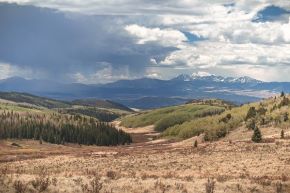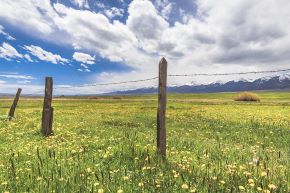- Home
- Admin
- Meetings
- Fry-Ark Project
- Projects
- Water Management
- Agriculture Conservation
- Arkansas River Basin Water Rights
- Conservation Plans
- Conservation & Education
- Education
- Fryingpan-Arkansas Project Water Import Tracking
- Inclusion into the Southeastern Colorado Water Conservancy District
- Legislation
- The Allocation of Fryingpan-Arkansas Project Water & Project Water Return Flows
- RRA
- Snow Pack Monitoring
- Water Conservation BMP Tool Box
- Winter Water Storage
- Water Wise Gardening
- Login
Plant Recommendations
Eastern Colorado is part of the shortgrass prairie region of the Great Plains with grama grass and buffalo grass making up 70% to 90% of all plant life. This semi-arid land is in the rain shadow of the Rocky Mountains and because of that it does not typically support trees except along creeks and rivers where there is more moisture. As you go up in elevation into the foothills and mountains you will see that there is much more precipitation that can support large forests and different plant ecosystems. Some of these higher elevation plants can grow in our gardens with supplemental watering and/or correct placement. With a bit of planning you can have a very diverse garden using only native plants if you like.
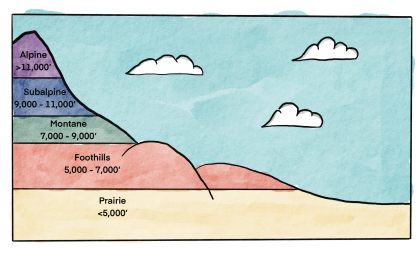
Local wildlife and pollinators have evolved alongside native plants and depend on each other to survive. As more and more of the landscape is developed by humans it is important that we help maintain the natural balance by incorporating these native plants into our gardens. Their resilience to local conditions conserves water, enriches soil, and reduces the need for excessive maintenance. Nature's own design has taken millennia to create this landscape and we should take inspiration from it when designing our own gardens.
The buzzing of bees and the fluttering of butterflies are not just sights and sounds of nature - they are essential forces of life. Through pollination, these remarkable creatures enable plants to reproduce, ensuring the continuation of our landscapes and the food systems we depend upon.
Birds and small mammals play a crucial role in plant ecosystems through seed dispersal. As these animals consume fruits and nuts, they inadvertently transport seeds to new locations, aiding in the colonization of diverse habitats. This process enhances plant genetic diversity, fosters plant growth, and supports ecosystem resilience by ensuring the spread of plant species and the renewal of plant populations. In this symbiotic relationship, they contribute significantly to the health and vitality of plant communities.
By emulating the wisdom embedded within the natural world, we embark on a journey to create gardens that echo nature's harmonious and enduring design.
Here you will find a list of important native plants to consider for your garden.
| Common Name | Scientific Name |
|---|---|
| American Plum | Prunus americana |
| Box Elder | Acer negundo |
| Chokecherry | Prunus virginiana |
| Colorado Pinyon Pine | Pinus edulis |
| Gambel Oak | Quercus gambelii |
| New Mexico Locust | Robinia neomexicana |
| New Mexico Olive | Forestiera pubescens |
| One-seed Juniper | Juniperus monosperma |
| Rocky Mountain Juniper | Juniperus scopulorum |
| Serviceberry | Amelanchier alnifolia |
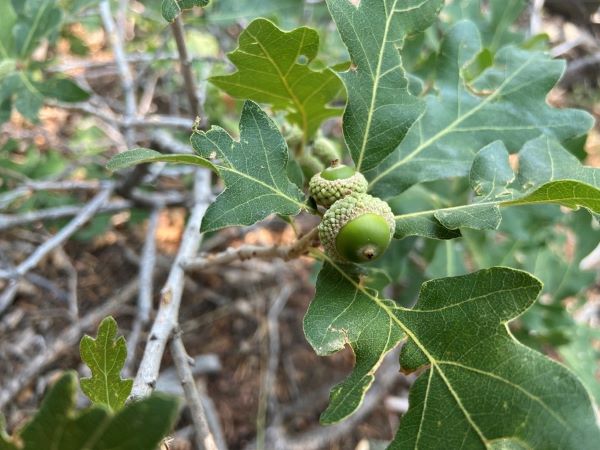
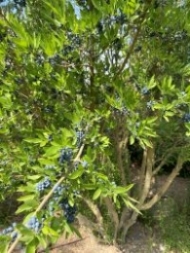
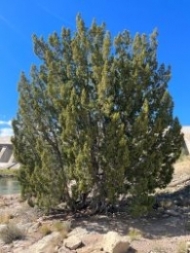

Quercus gambelii - Gambel Oak, Forestiera pubescens - New Mexico Olive, Juniperus monosperma - One-seed Juniper, Prunus americana - American Plum
| Common Name | Scientific Name |
|---|---|
| Alderleaf Mountain Mahogany | Cercocarpus montanus |
| Apache Plume | Fallugia paradoxa |
| Big Sagebrush | Artemisia tridentata |
| Boulder Raspberry | Rubus deliciosus |
| Fourwing Saltbush | Atriplex canescens |
| Golden Currant | Ribes aureum |
| Mountain Snowberry | Symphoricarpos rotundifolius |
| Red-berried Elder | Sambucus racemosa |
| Red Osier Dogwood | Cornus sericea |
| Rubber Rabbitbrush | Chrysothamnus nauseosus |
| Sandcherry | Prunus pumila besseyi |
| Three-leaf Sumac | Rhus trilobata |
| Wax Currant | Ribes cereum |
| Winterfat | Krascheninnikovia lanata |
| Woods' Rose | Rosa woodsii |
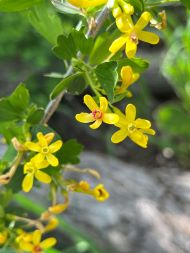
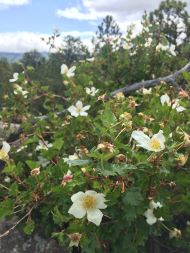
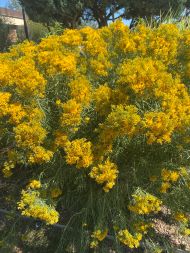
Ribes aureum - Golden Currant, Rubus deliciosus - Rocky Mountain Raspberry, Ericameria nauseosa - Rubber Rabbitbrush
| Common Name | Scientific Name |
|---|---|
| Adonis Blazingstar | Mentzelia multiflora |
| Bee Balm | Monarda fistulosa |
| Black-eyed Susan | Rudbeckia hirta |
| Blanket Flower | Gaillardia aristata |
| Blue Columbine | Aquilegia coerulea |
| Blue Flax | Linum lewisii |
| Colorado Four o'Clock | Mirabilis multiflora |
| Common Harebell | Campanula rotundifolia |
| Common Yarrow | Achillea millefolium |
| Desert Prince's Plume | Stanleya pinnata |
| Dotted Gayfeather | Liatris punctata |
| Firecracker Penstemon | Penstemon eatonii |
| Great Plains Yucca | Yucca glauca |
| Hairy False Goldenaster | Heterotheca villosa |
| Hoary Tansyaster | Dieteria canescens |
| Horsetail Milkweed | Asclepias subverticillata |
| Kinnickinnick | Arctostaphylos uva-ursi |
| Lance-leaved Coreopsis | Coreopsis lanceolata |
| Lanceleaf Stonecrop | Sedum lanceolatum |
| Mountain Springparsley | Vesper montanus |
| Narrow-Leaf Fireweed | Chamaenerion angustifolium |
| Nodding Onion | Allium cernuum |
| Pearly Everlasting | Anaphalis margaritacea |
| Prairie Coneflower | Ratibida columnifera |
| Prairie Pasqueflower | Pulsatilla nuttalliana |
| Prairie Smoke | Geum triflorum |
| Prairie Verbena | Glandularia bipinnatifida |
| Purple Coneflower | Echinacea purpurea |
| Rocky Mountain Iris | Iris missouriensis |
| Rocky Mountain Penstemon | Penstemon strictus |
| Scarlet Gilia | Ipomopsis aggregata |
| Scarlet Globemallow | Sphaeralcea coccinea |
| Scarlet Hedgehog Cactus | Echinocereus coccineus |
| Showy Milkweed | Asclepias speciosa |
| Shrubby Cinquefoil | Dasiphora fruticosa |
| Silver Lupine | Lupinus argenteus |
| Smooth Blue Aster | Symphyotrichum laeve |
| Spreadfruit Goldenbanner | Thermopsis divaricarpa |
| Spreading Fleabane | Erigeron divergens |
| Sulfur Buckwheat | Eriogonum umbellatum |
| Tall Goldenrod | Solidago altissima |
| Tufted Evening Primrose | Oenothera cespitosa |
| Western Red Columbine | Aquilegia elegantula |
| Western Wallflower | Erysimum capitatum |
| White Prairie Clover | Dalea candida |
| Wholeleaf Paintbrush | Castilleja integra |
| Winecup Mallow | Callirhoe involucrata |
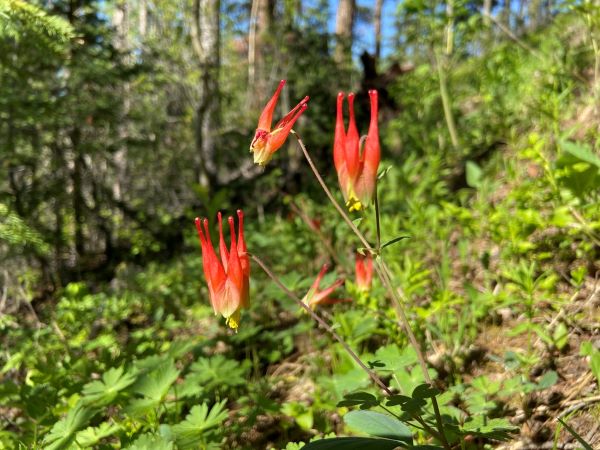
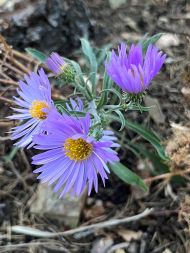
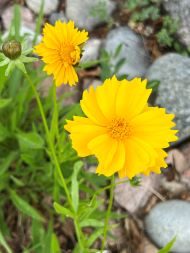
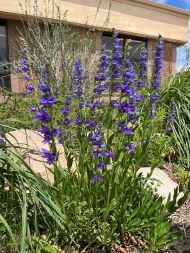
Aquilegia elegantula - Western Red Columbine, Dieteria canescens - Hoary Tasnyaster, Coreopsis lanceolata - Lance-leaved Coreopsis, Penstemon strictus - Rocky Mountain Penstemon
| Common Name | Scientific Name |
|---|---|
| Clammyweed | Polanisia dodecandra |
| Common Sunflower | Helianthus annuus |
| Firewheel | Gaillardia pulchella |
| Prairie Sunflower | Helianthus petiolaris |
| Rocky Mountain Bee Plant | Cleomella serrulata |

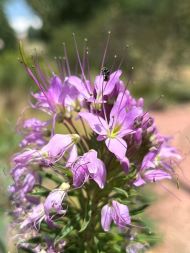
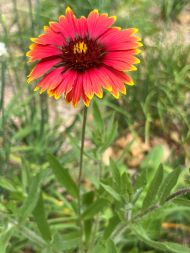
Helianthus annuus - Common Sunflower, Cleomella serrulata - Rocky Mountain Beeplant, Gaillardia pulchella - Firewheel
| Common Name | Scientific Name |
|---|---|
| Alkali Muhly | Muhlenbergia asperifolia |
| Alkali Sacaton | Sporobolus airoides |
| Big Bluestem | Andropogon gerardii |
| Blue Grama | Bouteloua gracilis |
| Indiangrass | Sorghastrum nutans |
| James' Galleta | Hilaria jamesii |
| Little Bluestem | Schizachyrium scoparium |
| Prairie Junegrass | Koeleria macrantha |
| Purple Threeawn | Aristida purpurea |
| Sand Dropseed | Sporobolus cryptandrus |
| Sideoats Grama | Bouteloua curtipendula |
| Switchgrass | Panicum virgatum |
| Western Wheatgrass | Elymus smithii |
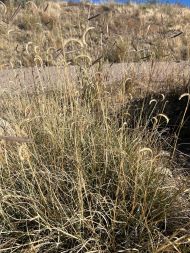
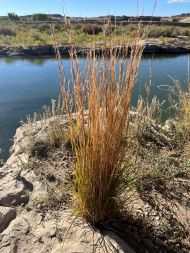
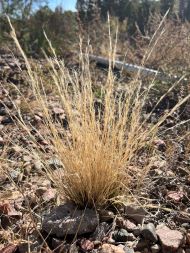
Bouteloua gracilis - Blue Grama, Schizachyrium scoparium - Little Bluestem, Aristida purpurea - Purple Threeawn
Learn More:
SECWCD - Recommended Native Plants: Grasses, Annuals and Perennials
SECWCD - Recommended Native Plants: Shrubs and Trees
SECWCD - Recommended Plants: Perennials and Annuals
SECWCD - Recommended Plants: Grasses, Cacti, Succulents, Agaves & Yuccas
U.S. National Park Service - Planting for Pollinators
National Wildlife Federation - Keystone Native Plants: Great Plains
Colorado Native Plant Society - Low Water Native Plants for Pollinators
Denver Audubon - Native Plants for Birds
Xerces Society - Native Plants for Pollinators and Beneficial Insects: Southern Plains
Xerces Society - Native Plants for Pollinators and Beneficial Insects: Rocky Mountains
Xerces Society - Native Plants for Pollinators and Beneficial Insects: SW Plateaus
Colorado State University Extension - Front Range Tree Recommendation List
City of Pueblo - Recommended Plant List
